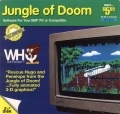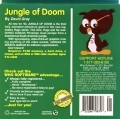Hugo III: Jungle of Doom!
First posted on 01 April 2015. Last updated on 02 April 2015.
In 1990, David Gray released Hugo's House of Horrors. The game introduced the protagonist Hugo who saved his girlfriend from being trapped inside a haunted mansion. Over time, the game gained a cult following for its tongue-in-cheek self-referential humor and for its almost satirical look on the common tropes of the adventure game genre. In 1991, Gray released the sequel Hugo II: Whodunit? which starred Penelope. While vacationing in a mansion belonging to Hugo's great uncle, Penelope was tasked to solve a murder mystery as she tried to find Hugo who went missing. Despite the change in settings, the distinct style of humor was still ever present. Above all, the game helped to board the appeal of the series to a wider audience.
With Hugo III: Jungle of Doom! Gray has kept his salt and pepper formula for the series. The sequel also serves as the concluding game to the Hugo trilogy. This time, Hugo and Penelope find themselves on a flight returning from the English countryside after their visit with Hugo's great uncle. Disaster soon strikes when a magnetic storm disrupts the plane's navigational instrument (namely the compass) and causes the plane to severely veer off course. The plane crash-lands in a South American jungle. Both Hugo and Penelope survive the crash. Hugo looks over the crashed plane as Penelope decides that the time is as good as ever to go exploring the jungle. Unfortunately, for Penelope, a large poisonous spider bites her and renders her unconscious. Now, it is up to Hugo to find the antidote to the spider's poison to try to save his beloved Penelope. Along the way, he meets some tribal natives, a lost elephant (in South America!), and other eccentric jungle inhabitants before a final confrontation with the old man from Hugo's past.
Gameplay in Hugo III: Jungle of Doom! is nearly identical to that of the previous games in the series. You still use the text parser to input basic word commands (the game is capable of understanding 2-3 word commands), such as LOOK IN BUSH, TALK TO NATIVE, or GET IN PLANE. However, you first need to position Hugo next to an object or a character with which you want to interact. Likewise, you need to position Hugo next to the target on which you want to use an item from your inventory. You can move Hugo by using the numeric keypad or by using the arrow keys on the keyboard. As expected, different characters will demand different items from Hugo. Some situations will require a few well thought-out uses of what you may, or sometimes may not, have on you.
The most noticeable difference between Hugo III: Jungle of Doom! and Hugo's House of Horrors as well as Hugo II: Whodunit? is the artwork. As opposed to the plain background art in previous games, the background art in this sequel is rich in details. The jungle is lush with shrubs, bushes, and trees. The sky is covered with clouds. The water in the river appears to be rippling. In fact, I have spent many moments in the game just admiring how much more beautiful the game looks. This is to the credit of the game's artist Gary Sirois, who has succeeded in making the game more aesthetically pleasing. It is a shame that Hugo III: Jungle of Doom! does not include an area like the garden maze in Hugo II: Whodunit? to further showcase Sirois' talent.
By contrast, the character art has changed little compared to that in previous games and are still drawn cartoon like animated pixels. However, the size of Hugo's character now changes to follow the perspective of the scene so that the character gets smaller in size as Hugo move away from and larger in size as Hugo moves closer to the foreground. This differs from Hugo's character in previous games in which the character size does not change. Foreground art, such as caves, walking trails, and cottages, is still perceptively textured. Even so, the animated fire in the native village is a particularly well done, and the geographically misplaced elephant (in South America) is nicely drawn. Some items (such as the crystal ball) that Hugo needs are not seen in the foreground until you look for it but are instead hidden behind other foreground objects.
Apparently, according to Gray, because of the increased production cost of the game due to the addition of professional artwork, the game is much shorter than previous games in the series. In fact, the game can be finished in as little as 20-30 minutes. Additionally, many scenes in the game feel more stretched out.
The game's difficulty has been tamed down as well. As opposed to previous games, Hugo cannot die in this game. There are a number of instances in which you will need precise timing to be able to complete a task. As well, at the very beginning of the game, there is an action that you need to do immediately, or else you will find yourself not having what you need later on to progress through the rest of the game. While the game has a few such dead ends, the ability to make multiple saves minimizes the chance that you will be completely stuck and need to restart the game. In all, it is a bit less of a concern to always tread lightly. Perhaps being the jungle of doom, death is more of an expectation than an exception. The game also introduces a new hint system. Hints are given generously and include step by step instructions to solve all of the puzzles. This makes the game by far the least difficult game in the Hugo series.
Hugo is told early in this game that he has only 48 hours to find the antidote to save Penelope. Yet, it is interesting that Gray does not capitalize on this story element to introduce a timed based mechanic into the game. This is perhaps understandable given the short length of the game.
The naturally lighthearted humor that is the hallmark of the Hugo series is still perpetually present in this sequel. You will find yourself smiling aplenty as you read through the descriptions and the character dialogs that are in most scenes. Given the jungle setting, it is fitting that the number of characters whom Hugo meets is far fewer. Consequently, the opportunity for humorous dialogs is also less.
Sound effects in this game remain minimal. They are limited to bleeps, bloops, and short non-MIDI melodies. The relative paucity of sounds, fortunately, does not take away the enjoyable gameplay that the game otherwise delivers.
For many fans of adventure games, the Hugo series holds a special air of nostalgia. It is comforting to know that Hugo III: Jungle of Doom! brings the series to a happy conclusion, at least for Hugo and Penelope. The only downside is that the game is too short, making it feel more like a pit stop in the jungle rather than a full on adventure in the wild. Still, for any adventure game fan seeking a bit of nostalgic diversion, the Hugo series makes for a perfect start to begin this journey.






